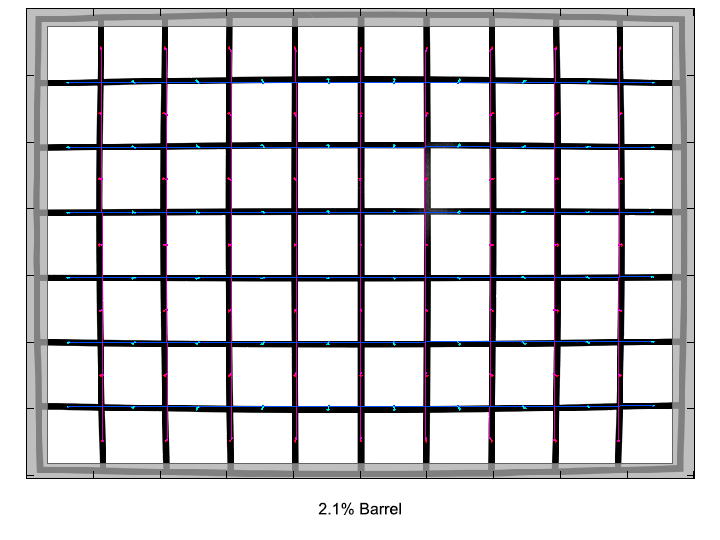|
Page 2 of 3

Distortion
The Distagon produces a moderate amount of barrel distortion of 2.1%. This is fairly good compared to competing lenses with a similar focal length, which often show far more distortion, sometimes on the edge of a fisheye effect. However, given the effort that Zeiss has put into the construction (and marketing) of the Distagon, it's still a little disappointing value, especially since for example the (even wider) Laowa 12mm f/2.8 Zero-D lens shows that less distortion on an extreme wide-angle lens is possible.
The good news, though: the distortion is almost perfectly symmetrical, so easy to correct in post processing. And for most subjects you'd shoot with such a wide lens, the distortion the Distagon produces is hardly visible or not noticeable at all. So, we're complaining on a high level here.

The chart above has a real-world size of about 120x80cm.
Vignetting
Ok, it's a Zeiss... and anyone familiar with their line of SLR-lenses already knows that if for whatever reason you want as little light fall-off as possible, Zeiss is maybe not the best choice. Still, even with these already lowered expectations, the vignetting results of the Distagon are disappointing, especially at large aperture settings.
At f/2.8, the corners darken by more than 3.5 stops on our test camera (which is way beyond the scale we use for the graph below... a scale that has served us well all the years). Of course the usual "cure" of stopping down eases the pain quite a bit, but being an ultrawide lens, there is an unavoidable amount of natural vignetting. So, even at f/8 and beyond, there's almost 1 stop of light fall-off left.
We're performing our vignetting analysis based on
(uncorrected) JPEGs straight from the camera. The JPG engine of the Nikon D3x features a rather flat
gradation curve, thus has a moderate contrast characteristic, resulting in comparatively low vignetting figures - the
corresponding Canon figures are roughly 40% higher due to the more
aggressive default contrast setting.

MTF (resolution)
So, so far the Distagon doesn't quite match the high expectations we had, but the MTF results change things into a much better direction.
In the image center the resolution is excellent straight from the largest aperture and stays on this high level throughout the whole tested aperture range.
Borders and especially extreme corners start out a little softer, but increase to very good resolution figures from f/5.6 onwards. The performance peak across the whole image frame is reached at f/8.
It's worth to mention the high contrast level of the lens, especially at large aperture settings where fast lenses often struggle. Just like high vignetting, this is also a typical behaviour of many Zeiss lenses - a way more welcome one, though.
Please note that the MTF results are not directly comparable across the different systems!
Below is a simplified summary of the formal findings. The chart shows line widths
per picture height (LW/PH) which can be taken as a measure for sharpness.
If you want to know more about the MTF50 figures you may check out the corresponding
Imatest Explanations

Chromatic Aberrations (CAs)
Lateral CAs (color shadows at harsh contrast transitions) range from around 0.8 pixels on the average at the image borders at f/2.8, increasing to just below 1 pixel stopped down to f/11. For such a wide lens, this is well controlled behaviour and hardly field-relevant.

|